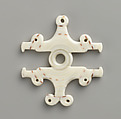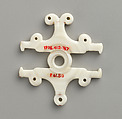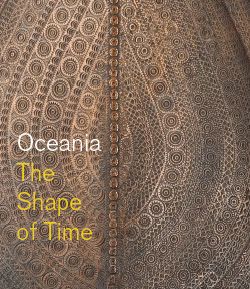Pendant
Not on view
Across Solomon Islands, men and women wear a wide variety of shell pendants and chest adornments. Made using materials from the land and the sea, adornments can communicate the status of the wearer, transform the body for ceremony, provide protection, or enable communication with ancestors.
This pendant, from New Georgia in the western Solomon Islands, is carved from a Conus shell and would have been worn by men for both every day and ceremonial occasions. Similar pendants could also be carved from nautilus shell or Tridacna (giant clam). It’s design features two mirrored pairs of frigatebirds. The name for frigatebirds in the New Georgia Islands is mbelama, which is also one of the names given to these pendants. The frigatebird plays an important role in the art and cosmology of Solomon Islands and wider Pacific. As a hunter of the sea and sky, frigate birds are seen to embody the qualities of a warrior as well as a guide to fishermen. Frigate birds also herald the annual arrival of large schools of bonito fish, which play a vital role in the economic and ceremonial lives of Solomon Islanders.
There are parallels between the adornment of human bodies and that of canoes in Solomon Islands. The mirrored frigate bird design seen here is also often replicated in canoe prow adornment in New Georgia. Pendants such as this are sometimes tied to the prows of canoes to increase the speed of the vessels and to ensure their safe passage on the ocean. Both the human body and canoes are seen as vessels capable of harnessing ancestral power when properly adorned.
Due to rights restrictions, this image cannot be enlarged, viewed at full screen, or downloaded.
This artwork is meant to be viewed from right to left. Scroll left to view more.





